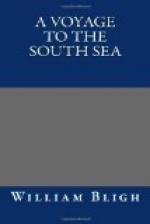Saturday 20.
When I went on shore I found Otow, Oberree-roah, Moannah, and several others in great tribulation at the thoughts that we were so soon to leave them. All the people of Matavai I saw were much concerned at my intention of going to Eimeo, and took every opportunity to prejudice me against the people of that island; to which I paid very little attention as their motive was obvious.
Sunday 21.
Their expressions of friendship and affection for me however I could not disregard, as I had no doubt of their being genuine and unaffected, and I felt my unwillingness to leave these kind people so much increased that the next day I sent the master in the launch to reexamine the depth of water between this bay and Toahroah harbour. He returned in the evening and acquainted me that he found a good bottom with not less than sixteen fathoms depth all the way. The harbour of Toahroah appearing every way safe I determined to get the ship there as speedily as possible, and I immediately made my intention public, which occasioned great rejoicing.
Wednesday 24.
This day we took the plants on board, being 774 pots, all in a healthy state; for whenever any plant had an unfavourable appearance it was replaced by another. The number of those rejected was 302, of which not one in ten but was found to be growing at the root.
The natives reckon eight kinds of the breadfruit tree, each of which they distinguish by a different name. 1. Patteah. 2. Eroroo. 3. Awanna. 4. Mi-re. 5. Oree. 6. Powerro. 7. Appeere. 8. Rowdeeah. In the first, fourth, and eighth class the leaf differs from the rest; the fourth is more sinuated; the eighth has a large broad leaf not at all sinuated. The difference of the fruit is principally in the first and eighth class. In the first the fruit is rather larger and more of an oblong form: in the eighth it is round and not above half the size of the others. I enquired if plants could be produced from the seed and was told they could not but that they must be taken from the root. The plants are best collected after wet weather, at which time the earth balls round the roots and they are not liable to suffer by being moved.
The most common method of dividing time at Otaheite is by moons; but they likewise make a division of the year into six parts, each of which is distinguished by the name of the kind of breadfruit then in season. In this division they keep a small interval called Tawa in which they do not use the breadfruit. This is about the end of February when the fruit is not in perfection; but there is no part of the year in which the trees are entirely bare.
Thursday 25.




